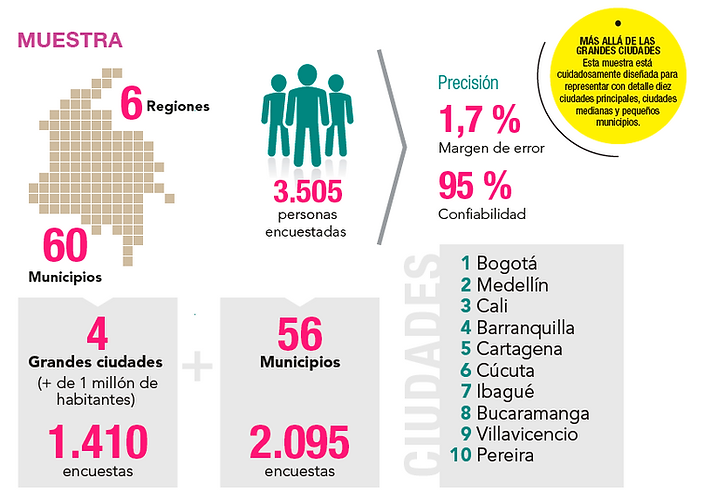
Apropiación Digital

Apropiación Digital 2025
El Estudio de Apropiación Digital 2025 del Centro Nacional de Consultoría revela cómo las personas en Colombia, Chile y Perú están integrando la tecnología en su vida diaria: desde la conectividad y la educación digital hasta la inclusión financiera y el uso creciente de la inteligencia artificial. El estudio consolida una mirada única sobre la madurez digital de la región y las brechas que aún debemos superar para transformar la tecnología en oportunidades reales de desarrollo






Noticias

¿QUÉ ES EL ESTUDIO DE APROPIACIÓN DIGITAL?
Apropiación Digital es un estudio nacional que descubre las diferentes formas en que la población colombiana le da uso a internet. Hoy la tarea de la cobertura de internet del país está quedando atrás para darle paso a un reto aún más grande: cómo convertir este esfuerzo de cobertura en progreso. Y esto, evidentemente, se logra a través de la apropiación digital.
Internet hoy permite medir con mucha precisión los comportamientos de los usuarios cuando están dentro de la red, e inclusive registrar la información de localización, salud, etc., que los diferentes dispositivos proporcionan sin que los usuarios sean conscientes de que están proporcionando dicha información. Sin embargo, existe muy poca información sobre las personas cuando no están conectadas. El estudio de Apropiación Digital 3.0 es un estudio de fuente única que desvela con detalle los comportamientos y actitudes que las personas tienen en relación con el mundo digital.
A pesar del exceso de información de la red, existe muy poca información sobre las personas cuando no están conectadas

CARACTERÍSTICAS
El estudio de Apropiación Digital reúne con una visión profunda las formas en que las personas están haciendo uso de internet. Esta información pone al descubierto la perspectiva que tiene la apropiación en Colombia. Pero el estudio no se queda ahí. Nuestro esfuerzo es descubrir cómo son esos usos, esas capas que conforman la relación que tiene la población con lo digital. Estas capas nos permitirán identificar cómo la gente está iniciándose en la red, si aún el e-mail es su puerta de entrada o si los dispositivos móviles han alterado este orden y hoy son el chat y las redes sociales las formas en que la gente se involucra en la red. A través de estas capas de información Podremos ver con nitidez las combinaciones de usos que crean espacios fértiles para el e-commerce, la bancarización, la educación, el internet de las personas y de las cosas, los pro-consumidores y el posconflicto, entre otros. Esta especie de altimetría de la apropiación nos permitirá tener información útil para crear estrategias digitales más acertadas en casi cualquier área.
La altimetría de la apropiación permitirá tener información útil para crear estrategias digitales acertadas


El internet de las personas
-
Uso y usos de redes sociales
-
Las interacciones sociales digitales Vs las personales
-
Privacidad y riesgos en internet. Percepciones frente a los usos derivados de compartir información en internet
-
Comunidades digitales
-
Opiniones de los padres frente internet
-
Usos de internet, orden de adopción y tiempo invertido por actividad
-
La tecnología y su trabajo: lo mejora o lo pone en riesgo
-
Búsqueda de empleo y preparación para el trabajo

Bancarización y sus usos digitales
-
Se informa, adquiere y/o se relaciona con el banco por canales digitales
-
Tipo de uso por producto financiero
-
Los bancarizados qué transacciones hacen en internet
-
Nivel de confianza en las transacciones

Comercio Electrónico
-
Quiénes compran y quiénes venden en internet. Lo hacen como negocio
-
Qué se compra y qué se vende en internet
-
A quién le compran en internet: a personas, a locales mixtos o a locales exclusivos en internet
-
Medios de pago utilizados y preferidos para pagar compras en internet
-
Artículos que ha comprado y los que nunca compraría en internet
-
Apps que usa en las que paga por productos o servicios
-
Las redes sociales y los negocios
-
Gasto en compras on-line

El internet de las cosas: La conciencia de la relación cotidiana con los sensores
-
Quiénes compran y quiénes venden en internet. Lo hacen como negocio
-
Qué se compra y qué se vende en internet
-
A quién le compran en internet: a personas, a locales mixtos o a locales exclusivos en internet
-
Medios de pago utilizados y preferidos para pagar compras en internet
-
Artículos que ha comprado y los que nunca compraría en internet
-
Apps que usa en las que paga por productos o servicios
-
Las redes sociales y los negocios
-
Gasto en compras on-line

La publicidad en internet
-
Opinión frente a los anuncios en buscadores
-
Valoración de la publicidad en internet
-
Interés en la publicidad que recibe a través de redes sociales (incluido YouTube) y páginas web
-
Prefiere gratis con publicidad o pagando y sin publicidad
-
Quiénes usan la opción de saltar la publicidad
-
Membrecías a programas de cliente marcado. Interacciones y usos deseables y no deseables
-
Dispositivos, formatos, tipos de contenido en que recibe y consulta publicidad

Uso de apps en el móvil
-
App que han impactado notoriamente su forma de trabajar, estudiar o que han mejorado la calidad de vida
-
Hay alguna app gratis que usted use y por la que pagaría si se requiriera
-
Pago por Apps que no funcionan como esperan los compradores

Uso de pantallas
-
Crecimiento del tamaño de las pantallas. Cambio del dispositivo anterior al actual en: televisores, Smartphone, computador, tableta
-
Momentos de uso asociados a cada dispositivo
-
Momento de concurrencia entre pantallas
-
Contenidos enlazados entre pantallas

Pago de suscripciones a servicios OTT
-
Aplicaciones de video
-
Aplicaciones de audio
-
Beneficios frente a sitios sin pago.

La Nube
-
Uso y disposición a usar
-
Pago por almacenamiento
-
Tipo de contenido que se almacena

Educación
-
Acceso a la educación virtual
-
Valoración de la educación virtual
-
Dinero invertido en educación virtual en el hogar





















